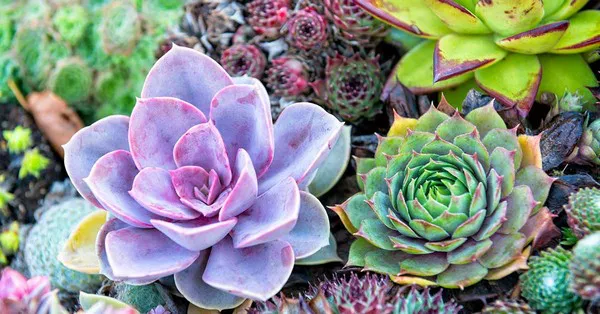Succulents have gained immense popularity among garden enthusiasts due to their unique and resilient nature. These drought-tolerant plants bring a touch of elegance and charm to any garden. While succulents can stand out on their own, pairing them with complementary flowers can create stunning visual displays and add a splash of color to your garden. In this article, we will explore some fantastic flower choices that can enhance the beauty of your succulent garden.
1. Low-Maintenance Companion Flowers
When selecting flowers to plant with succulents, it is important to choose varieties that have similar water and sunlight requirements. Opt for low-maintenance flowers that can thrive alongside your succulents without competing for resources. Here are a few recommendations:
a. Zinnias (Zinnia spp.): Zinnias are vibrant, daisy-like flowers available in various colors. They require minimal care, are drought-tolerant, and bloom throughout the summer. Plant them with succulents to create a delightful burst of color.
b. Marigolds (Tagetes spp.): Marigolds are popular companion flowers for succulents. Their bright yellow, orange, and red blooms complement the muted tones of many succulent varieties. Marigolds repel certain pests, making them a beneficial addition to your garden.
c. Cosmos (Cosmos spp.): Cosmos flowers feature delicate, daisy-like blooms in shades of pink, purple, and white. They are low-maintenance, attract pollinators, and their airy appearance adds a whimsical touch when combined with succulents.
2. Contrasting Textures and Forms
Pairing succulents with flowers that have contrasting textures and forms can create visually striking combinations. The succulents’ structural foliage and the flowers’ soft petals create an appealing contrast. Consider the following flowers for an eye-catching display:
a. Verbena (Verbena spp.): Verbena flowers are known for their clustered blooms in vibrant shades of pink, purple, and red. Their slender, trailing growth habit contrasts beautifully with the compact and structured forms of succulents.
b. Gazania (Gazania spp.): Gazania flowers feature bold, daisy-like blooms in vivid colors such as yellow, orange, and red. The petals often have interesting patterns, adding visual interest when paired with succulents. Gazanias are drought-tolerant and well-suited for arid gardens.
c. Blanket Flower (Gaillardia spp.): Blanket flowers are drought-tolerant perennials that produce showy, daisy-like blooms in vibrant shades of red, orange, and yellow. Their vibrant colors and fringed petals provide an attractive contrast to the architectural foliage of succulents.
3. Color Complementing Combinations
Choosing flowers that complement the colors of your succulents can create a harmonious and visually pleasing garden. Consider the following flower choices to complement different succulent hues:
a. Purple Hues: Pair purple or lavender succulents such as Echeveria ‘Lola’ or Sedum ‘Purple Emperor’ with complementary flowers like lavender (Lavandula spp.), Russian sage (Perovskia atriplicifolia), or purple coneflower (Echinacea purpurea).
b. Bright Yellow and Orange: Succulents with bright yellow or orange tones, such as Sedum ‘Angelina’ or Aloe ‘Firecracker,’ can be enhanced by planting them alongside flowers like coreopsis (Coreopsis spp.), black-eyed Susan (Rudbeckia spp.), or sunflowers (Helianthus spp.).
c. Soft Pink and Peach: Succulents with soft pink or peach hues, such as Graptosedum ‘California Sunset’ or Echeveria ‘Perle von Nürnberg,’ can be complemented by flowers like cosmos (Cosmos spp.), sweet peas (Lathyrus spp.), or roses (Rosa spp.).
4. Vertical Interest
Incorporating flowers that add height and vertical interest to your succulent garden can create a visually dynamic and multi-dimensional display. Here are some flowers that can provide vertical accents:
a. Salvia (Salvia spp.): Salvias are perennial flowers that come in a variety of colors, including vibrant blues, purples, and reds. Their tall, upright spikes add vertical interest and create a stunning backdrop for low-growing succulents.
b. Mexican Feather Grass (Nassella spp.): Mexican Feather Grass is an ornamental grass with delicate, feathery seed heads that sway gracefully in the breeze. Its airy texture and slender form create a beautiful contrast to the sturdy and compact succulent foliage.
c. Foxglove (Digitalis spp.): Foxgloves are biennial flowers that produce tall spires adorned with bell-shaped blooms in shades of pink, purple, white, and yellow. These majestic flowers can add height and drama to your succulent garden.
5. Ground Covers and Fillers
To create a lush and full look, consider incorporating ground covers and filler flowers that spread and fill in the gaps between succulents. These plants help suppress weeds and create a cohesive visual display. Here are a few options:
a. Creeping Thyme (Thymus spp.): Creeping thyme is a low-growing ground cover that forms a dense mat of fragrant foliage and produces small, delicate flowers in shades of pink, purple, or white. It can serve as a charming filler around succulent plantings.
b. Baby’s Breath (Gypsophila spp.): Baby’s Breath is a delicate and airy filler flower known for its clusters of small white or pink blooms. Its delicate appearance creates a soft contrast against the textured and structural succulent foliage.
c. Sweet Alyssum (Lobularia maritima): Sweet Alyssum is a low-growing annual flower that produces clusters of tiny fragrant blooms in shades of white, pink, or purple. It is an excellent ground cover that adds a carpet of color and attracts beneficial insects.
Conclusion
Pairing flowers with succulents can elevate the beauty of your garden, creating stunning combinations of colors, textures, and forms. Whether you opt for low-maintenance companions, contrasting textures, color-complementing combinations, vertical accents, or ground covers, there is a wide range of flowers to choose from. By selecting flowers that thrive in similar growing conditions and enhance the unique characteristics of succulents, you can create a visually captivating and harmonious garden that showcases the best of both worlds.


